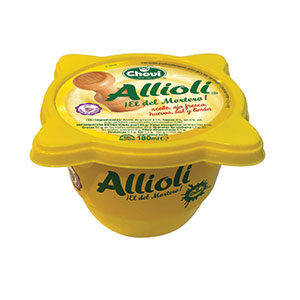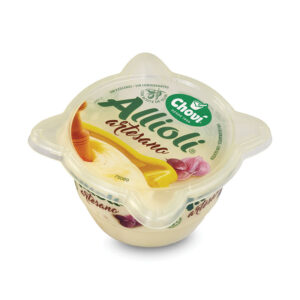El alioli es una salsa mediterránea más versátil de lo que te puedes imaginar. ¡Pruébalo ya con carne, con pescado, con tus platos de arroz..!
Aioli is a sauce that is closely linked to the Mediterranean tradition. Did you know that it has been used since before the 10th century in Spain? Choví’s aioli recipe respects this tradition and that is why it is so successful.
How do we do it? Although the preparation is fundamental, everything starts by the aioli’s ingredients.If they are high-quality ingredients,it will be difficult to surpass the result.
If you want to make aioli yourself, take note of the ingredients we use at Choví. These are the high-quality ingredients that you will also find if you buy our Choví product..

One of the essentials for a good homemade aioli.The better de oil, the better the sauce. Choose the oil you want to use wisely. Depending on the flavour intensity you are looking for, you will need to choose one sort of oil or another. Not all of them are the same! For instance, our traditional sauce has a more intense flavour thanks to its 72% of oil content.

Garlic reduces the amount of cholesterol and has antioxidant properties. Indeed, it is the most important ingredient in the aioli recipe. Therefore, you must also know how to make a good garlic choice. For all of our sauces at Choví, we use purple garlicand we use it fresh and whole so it does not lose its aroma.


Together with salt, lemon helps give the recipe its final touch. In case you are not an enthusiast of sour tastes, you can skip this ingredient. However, as you will notice in Choví’s aioli sauces, this is an extremely subtle touch that grants it a perfect flavour nonetheless.

As if it were made at home,Our Classic Mortar Aioli is our most popular recipe. Even the most exigent aioli pundits approve it. It is prepared with all of the aioli ingredients we have mentioned. Besides, there are several formats at your disposal, all of them with the characteristic mortar that has made our aioli famous internationally.
Our Classic Aioli features a traditional flavour with 6% of garlic content.

Apt for the most exigent, the enthusiasts of authentic flavours. This recipe has been devised for offering a more traditional flavour. With genuine olive oil and preservative free, this is the perfect sauce for the most traditional recipes.
Our Traditional Aioli features with a genuine flavour with 10 % of garlic content.

Our mild flavour,apt even for those who are not really garlic lovers.
This Aioli Sauce is particularly creamy and is smoother if compared to the Classic Aioli.
This sauce features a smooth flavour with 3 % of garlic content..
You think aioli is nothing more than an accompaniment sauce, but you're wrong! It can be used in many recipes to give them a different and unique flavour.
The classic potato recipes with aioli, also used as a topping for your baked potatoes. a delicious cuttlefish dish, to gratin over cod or a spectacular baked hake,... Although, if your thing is rice and fideuá, traditional fideuá recipes, arroz a banda, should not be missing on your radar. Or maybe your body is asking for a more modern dish? Then you have to try these recipes with avocado aioli.
Fish recipes with allioli, meat recipes and, of course, recipes with the most traditional rice dishes of the Mediterranean tradition. If you consider yourself a fan of this sauce, why not try these recipes?
We have warned you… We are aioli pundits! We love preparing all of our unique aioli recipes and we know everything about the sauce. Do you want to know it all too? These are some curiosities about aioli sauce.
You may associate aioli to a terrace beside a Spanish Mediterranean beach but, in truth, aioli has travelled a lot since its beginnings. All evidence suggests that aioli sauce was invented in ancient Egypt.
The Romans took a liking to this sauce during their invasion. In fact, they liked it so much that they commonly used it in many areas of the Roman Empire after they discovered it, especially in Mediterranean areas such as the Italian Peninsula, Sicily, Calabria, Valencia, the Balearic Islands, Catalonia, Murcia or Andalusia.
But this is not the only version of the story! Others say that the Iberians, the dwellers of the Iberian Peninsula before the Romans arrived, already used a very similar sauce that had oil and garlic as the main ingredients.
This could mean that this sauce appeared simultaneously in different regions where oil and garlic were harvested.
Although its invention occurred much sooner, this sauce was first used in the 10th century. That is why aioli appears in some of the oldest preparations of Mediterranean cuisine.
Actually, those recipe books include different aioli preparations. Of course, oil and garlic are the essential ingredients in all of them. What changes is the beating intensity and, therefore, the sauce density and creaminess.
Some of the ingredients change as well. As a matter of fact, we can find some versions with milk or cream cheese.
There is no doubt that this is a very controversial subject: what is the official name for aioli sauce? In Catalan-speaking regions, the sauce is referred to as allioli, a fusion of the words all (garlic) and oli (oil): all-i-oli.
Although this word has been shortened to the spelling 'alioli', there are still more versions. Some refer to this sauce as ajoaceite or even ajiaceite.
In short, there seem to be as many ways of referring to this delicious sauce as there are recipes, but which one is the official one?
The dictionary of the Real Academia Española includes all these versions except for allioli, as this word is officially in Catalan. Both ajoaceite and ajiaceite are included in the dictionary, although the recommended form, also by the Fundeu, is Aioli.
